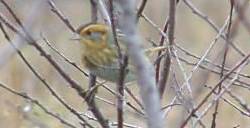- Nelson's Sharp-tailed Sparrow
Taxobox
name = Nelson's Sharp-tailed Sparrow
status = LC | status_system = IUCN3.1

regnum =Animal ia
phylum = Chordata
classis = Aves
ordo =Passeriformes
familia = Emberizidae
genus = "Ammodramus "
species = "A. nelsoni"
binomial = "Ammodramus nelsoni"
binomial_authority = Allen, 1875The Nelson's Sharp-tailed Sparrow, "Ammodramus nelsoni", is a small sparrow. Formerly, this bird and theSaltmarsh Sharp-tailed Sparrow were considered to be a single species, the Sharp-tailed Sparrow.Adults have brownish upperparts with grey on the crown and nape, a cream-coloured breast with light or indistinct streaking and a white throat and belly; they have an orange face with grey cheeks and a short pointed tail.
Their breeding habitat is
marsh es on the Atlantic coast ofCanada andMaine , centralCanada , (theCanadian Prairies region and acoastal strip on the south ofHudson Bay ), and the north centralUnited States . The nest is an open cup attached to vegetation and close to the ground. Males compete for females but do not defend territories; they sometimes help feed the young. Mating is largely promiscuous by both sexes; multiple paternity in a nest is common.These birds migrate to the southeastern coasts of the United States.
These birds forage on the ground or in marsh vegetation, sometimes probing in mud. They mainly eat insects, aquatic
invertebrate s and seeds.The call is a raspy trill, almost a mechanical sound. It may be given in flight during the nesting season. The sound has been likened to a drop of water hitting a hot fry pan.
This bird was named after
Edward William Nelson , an American naturalist.References
* Database entry includes justification for why this species is of least concern
External links
* [http://www.sdakotabirds.com/species/nelsons_sharp_tailed_sparrow_info.htm Nelson's Sharp-tailed Sparrow Information] - South Dakota Birds and Birding
* [http://www.birds.cornell.edu/AllAboutBirds/BirdGuide/Nelsons_Sharp-tailed_Sparrow.html Nelson's Sharp-tailed Sparrow Species Account] - Cornell Lab of Ornithology
* [http://www.mbr-pwrc.usgs.gov/id/framlst/i5491id.html Nelson's Sharp-tailed Sparrow - "Ammodramus nelsoni"] - USGS Patuxent Bird Identification InfoCenter
* [http://vireo.acnatsci.org/search.html?VIREO_SESSION_ID=980a83f8970829483824114650f5247e&Form=Search&SEARCHBY=Common&KEYWORDS=nelson%27s+sharp-tailed+sparrow&showwhat=images&AGE=All&SEX=All&ACT=All&Search=Search&VIEW=All&ORIENTATION=All&RESULTS=24 Nelson's Sharp-tailed Sparrow photos] VIREOFurther reading
Articles
* Chan YL, Hill CE, Maldonado JE & Fleischer RC. (2006). "Evolution and conservation of tidal-marsh vertebrates: Molecular approaches". Studies in Avian Biology. vol 32, p. 54-75.
* Erwin RM, Sanders GM, Prosser DJ & Cahoon DR. (2006). "High tides and rising seas: Potential effects on estuarine waterbirds". Studies in Avian Biology. vol 32, p. 214-228.
* Fry AJ. (1999). "Mildly deleterious mutations in avian mitochondrial DNA: Evidence from neutrality tests". Evolution. vol 53, no 5. p. 1617-1620.
* Hanson AR & Shriver WG. (2006). "Breeding birds of Northeast saltmarshes: Habitat use and conservation". Studies in Avian Biology. vol 32, p. 141-154.
* Hodgman TP, Shriver WG & Vickery PD. (2002). "Redefining range overlap between the Sharp-tailed Sparrows of coastal New England". Wilson Bulletin. vol 114, no 1. p. 38-43.
* Ludwick TJ & Murphy RK. (2006). "Fire history, passerine abundance, and habitat on a North Dakota drift plain prairie". Prairie Naturalist. vol 38, no 1. p. 1-11.
* Nocera JJ, GJ Forbes & GR Milton. (2007). "Habitat relationships of three grassland breeding bird species: broad-scale comparisons and hayfield management implications". Avian Conservation and Ecology. vol 2, no 1. article 7. View article at: [http://www.ace-eco.org/vol2/iss1/art7/]
* Nocera, JJ, TM Fitzgerald, AR Hanson & GR Milton. (2007). "Differential habitat use by Acadian Nelson’s Sharp-tailed Sparrow: implications for regional conservation". Journal of Field Ornithology. vol 78, p. 50-55.
* Nocera JJ, Forbes GJ & Giraldeau L-A. (2006). "Inadvertent social information in breeding site selection of natal dispersing birds". Proceedings of the Royal Society Biological Sciences Series B. vol 273, no 1584. p. 349-355.
* Nocera JJ, Parsons GJ, Milton GR & Fredeen AH. (2005). "Compatibility of delayed cutting regime with bird breeding and hay nutritional quality". Agriculture Ecosystems & Environment. vol 107, no 2-3. p. 245-253.
* Nordhagen TJ, Nordhagen MP & Hendricks P. (2005). "Nelson's Sharp-tailed Sparrow nest parasitized by Brown-headed Cowbird". Wilson Bulletin. vol 117, no 4. p. 403-404.
* Post W. (1998). "The status of Nelson's and saltmarsh sharp-tailed sparrows on Waccasassa Bay, Levy County, Florida". Florida Field Naturalist. vol 26, no 1. p. 1-6.
* Rising JD. (2001). "Geographic variation in size and shape of Savannah Sparrows (Passerculus sandwichensis)". Studies in Avian Biology. vol 23, p. 1-65.
* Shriver WG, Gibbs JP, Vickery PD, Gibbs HL, Hodgman TP, Jones PT & Jacques CN. (2005). "Concordance between morphological and molecular markers in assessing hybridization between sharp-tailed sparrows in New England". Auk. vol 122, no 1. p. 94-107.
* Waters A. (2004). "First augusta record of nelson's sharp-tailed sparrow". Oriole. vol 69, no 1-2.
Wikimedia Foundation. 2010.
